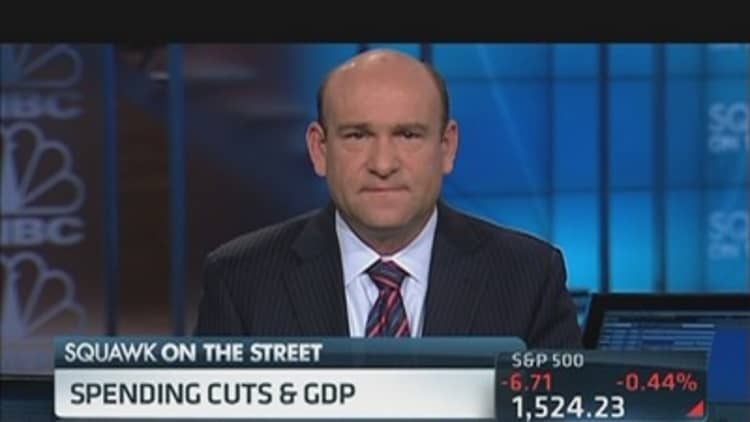
With the White House and the speaker's office publicly throwing barbs at each other, Wall Street increasingly believes the federal budget cuts known as the sequester are likely to take effect March 1.
"An 11th-hour deal is always possible," Credit Suisse economist Neal Soss wrote in a research report. "But there aren't the usual signs that Washington is near a breakthrough."
(Read More: Alan Simpson Presses for Larger 'Grand Bargain'.)
That means going through what has now become the routine practice of calculating the economic and market impacts of a worst-case Washington scenario.
Under the sequester, federal outlays will be cut by $85 billion this year and $1.2 trillion over 10 years, equally hitting defense and nondefense spending with only some program, like Social Security and military pay, exempted.
Soss is among the economists who believe it will shave about a half a percentage point off of growth. In the case of Credit Suisse, that means 2013 growth will be 1.5 percent instead of 2 percent.
That's a pretty critical markdown. It brings the economy far below the level of growth rate that most economists think is necessary to reduce the unemployment rate. Many economists said allowing the sequester to take effect would cost about a half million jobs and boost the unemployment rate by 0.25 to 0.3 percentage points.
(Read More: Obama Warns Sequester Will Cause Job Losses.)
The St. Louis forecasting firm Macroeconomic Advisers puts the end of the year unemployment at 7.9 percent instead of its original estimate of 7.6 percent because of the sequester.
Overall, the firm said, the sequester by itself is not catastrophic. But it added, "Nevertheless, the indiscriminate fiscal restraint would come on the heels of tax increases in the first quarter that total nearly $200 billion, with the economy still struggling to overcome the legacy of the Great Recession, and when the FOMC is constrained in its ability to offset the additional fiscal drag with a more accommodative monetary policy."
Nomura believes the sequester will hit for a few weeks but then an agreement later in the month will undo the cuts. If that's the case, then Wells Fargo could be right in advising investors to buy the dips created by market sequester concerns.
(Read More: Why Sequestration Will Hit Housing on Several Fronts.)
"In the end we are not looking for a significant cut in government spending this year,'' Wells Fargo wrote. "We would be equity buyers on any pullback that occurs as a result of the upcoming spending negotiations in Washington."
The belief that Washington will ultimately pull back from the abyss—as it has the last two times of budget brinksmanship—is one reason why stock values seem to be holding up well as the sequester deadline nears.
Another potential offset, according to Macro Advisers will come next year from the Federal Reserve. While the sequester will still be reducing growth, Macro believes this will prompt the Fed to keep interest rates lower than it otherwise would have. The economic impact of lower rates should offset the effects of budget cuts.
Ironically, if the sequester hits, the sequester itself could be the last of Wall Street's concerns. "If Congress can't agree on a budget deal, the sequestration will be a relatively minor problem," Capital Economics wrote. "The deadlock would probably trigger a government shutdown."
—By CNBC's Steve Liesman; Follow him on Twitter: @steveliesman


